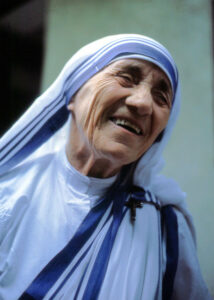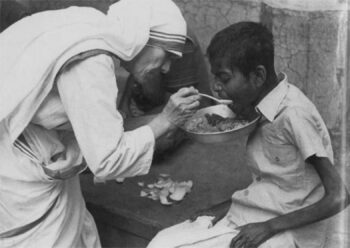St Teresa of Kolkata Love in Action

Victor Parachin

Photo: Manfred Ferrari, 2003
Part 1
This is a hall of words.
A few days ago we had, in this rostrum, the most powerful men in the world.
Now we have the privilege to have the most powerful woman in the world
....she is much more than I, much more than all of us.
She is the United Nations.
She is peace in this world.
Those glowing words came from Javier Perez de Cuellar, 5th General Secretary to the UN, when he introduced Mother Teresa to the United Nations General Assembly, October 26, 1985. In addition to being called “the most powerful woman in the world” Mother Teresa has also been described in many other magnanimous words - a living saint, Nobel Peace Prize winner, Blessed Teresa of Calcutta, symbol of hope, spiritual master, the saint of the gutters, most admired person of the century by The Gallup Organisation.
The woman who would become Mother Teresa was born Gonxha (Agnes) Bojaxhiu on August 27, 1910 in Skopje, Albania. She received a call to serve the poor at a young age: “I was only twelve years old, living with my parents in Skopje, when I first sensed the desire to become a nun,” she said. “It was then that I realised that my call was to the poor.” Thus, at the age of 18 in 1928 she left home for Dublin, Ireland where she enter the convent of the Sisters of Loreto, an order devoted to the education of young girls. After one year in Dublin, she went to Calcutta, India where she took her formal vows as a nun adopting the name 'Teresa' honouring her two female spiritual mentors, Teresa of Avila and Thérèse of Lisieux.
Although Mother Teresa enjoyed her students and her vocation as a teacher, she was deeply agitated by the overwhelming poverty she saw in the streets of Calcutta. She reflected and prayed about this increasing inner discomfort which she was experiencing. Finally, on September 10, 1946, she perceived a “call within a call.” She was to leave her convent and help the poor while living like them and among them.
To move forward with her new calling Mother Teresa would need permission from her superiors and from Rome. In order for that to take place, Mother Teresa knew that the support of the Archbishop of Calcutta, Ferdinand Perier, was essential. Archbishop Perier, though sympathetic, tested her calling by insisting she spend more time in lengthy meditation, prayer, and spiritual consultation. If, after that, she still felt called to proceed, then the Archbishop wanted her to write answers to a number of questions which are detailed below.
Archbishop Perier further asked Mother Teresa to keep it simple saying: “It is not desired to have a long description of what you fancy you will be able to do. Tell us what we want to know in a few words.”
 A few months later, Mother Teresa answered his questions, adding a ninth one of her own. Writing to the Archbishop, Mother Teresa began her letter: “Today, after much prayer, I shall try with His help, to answer your questions.” Abiding by his request for brevity, Mother Teresa offered the following answers:
A few months later, Mother Teresa answered his questions, adding a ninth one of her own. Writing to the Archbishop, Mother Teresa began her letter: “Today, after much prayer, I shall try with His help, to answer your questions.” Abiding by his request for brevity, Mother Teresa offered the following answers:
1. What exactly and in detail do you want to do?
“Our Lord wants Indian Nuns, victims of His love, who would be so united to Him as to radiate His love on souls ...be His light, His fire of love amongst the poor, the sick, the dying, the beggars and the little street children.”
2. The means by which you desire to bring it about?
“By going amongst the people. Nursing the sick in their homes. Helping the dying to make their peace with God. Having little free schools in the slums for the little children. Visiting the poor in hospitals. And helping the beggars of the streets to lead respectful lives. In a word, act the charity of Christ amongst the poorest.”
3. How would you form your disciples?
“By giving them a complete knowledge of the spiritual life so that … they would live the life of close union with God. The interior life must become the main power of the exterior. To arrive at this the Sisters will have the first year of their religious life – one of complete contemplation and perfect solitude, which will be renewed every six years after they have taken the vows.”
4. What kind of people would you recruit for this work?
“Girls from the age of sixteen upwards – Strong in body and mind with plenty of common sense. No special qualification ...generous and lovers of the poor. They must be able to put their hands to any kind of work however repugnant to human nature. They must be of bright, cheerful disposition.”
5. Where would be the centre of your work?
“For the present the slums and the streets of Calcutta (and later) all the big towns of India. We shall not wait to be asked to do this or that work by this or that Bishop or priest. We shall go in search of souls ourselves and offer our services.”
6. Whether it is not possible to obtain this end by congregations already in existence?
“No. First, because they are European. When our Indian girls enter these orders – they are made to live their life – eat, sleep, dress like them (Europeans).” Missionaries of Charity would be “Indian Nuns, dressed in Indian clothes, leading the Indian life” adding that “whoever desires to be a Missionary of Charity will have to become Indian – dress like them, live like them.”
7. Whether it would not be more conducive to use a kind of association.
“For the life they would have to live, seculars would not be able to do it. For a work of continual self-forgetfulness and immolation for others, you need interior souls – burning with love for God and souls. Pure souls who would see and seek God in the poor.”
8. The possibilities of success.
“I don't know what the success will be but if the Missionaries of Charity have brought joy to one unhappy home, made one innocent child from the street pure for Jesus, one dying person die in peace with God...it would be worth while offering everything for just that one because that one would bring great joy to the heart of Jesus.”
9. How would the sisters support themselves (my question)?
“From the farm they should be able to get most of their food. They will sell some and so buy the other things. As for the clothes, they will make toys and pictures and other hand work things which will be sold and with that money get what is most necessary. We shall need very little as we intend with the grace of God to keep absolute poverty.”
These answers became the blueprint for the way Mother Teresa's new order, the Missionaries of Charity, would function. Her process of being released from the Sisters of Loreto as well as gaining permission from Rome took nearly two years.
On August 16, 1948, Mother Teresa replaced her European religious habit of the Sisters of Loreto with a white Indian sari and began her mission to serve the poorest of the poor, one which would make her one of the most inspiring and important persons of the twentieth century.
Wisdom from Mother Teresa
◆“If you judge people, you have no time to love them.”
◆“My God is called love.”
◆“There are many people who can do big things, but there are very few people who will do the small things.”
◆“If we really want to pray we must first learn to listen, for in the silence of the heart God speaks.”
◆“I believe politicians spend too little time on their knees. I am convinced that they would be better politicians if they were to do so.”
◆“Smile at each other, smile at your husband, smile at your children, smile at everyone - it doesn't matter who it is - and that will help you to grow up in greater love for each other.”
◆“If we really want to love we must learn how to forgive.”
◆“The hunger for love is much more difficult to remove than the hunger for bread.”
◆“Yesterday is gone. Tomorrow has not yet come. We have only today. Let us begin.”
 Entries(RSS)
Entries(RSS)